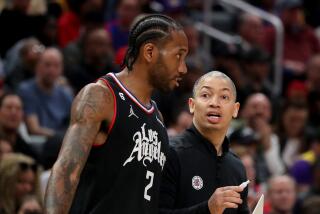ITâS BASIC TRAINING : After Disappointing â86 Season, Springtime Means Overtime for Dodger Shortstop Duncan
VERO BEACH, Fla. â Days are long enough here without someone calling you back for more work after almost everyone else has gone home.
This is spring training, after all, and Mariano Duncan says he has never had an aversion to training hard any time of the year. Still, there are limits, and by mid-afternoon one recent day, the Dodger shortstop looked as though he had reached his.
He walked into the clubhouse a little past 3 p.m., glistening with sweat after five hours of toiling in 80-degree heat and stifling humidity. Hovering near the deli spread alongside other players, Duncan was approached by a reporter.
âCanât talk now,â Duncan said.
Turns out that infield coach Bill Russell had summoned Duncan and second baseman Steve Sax back to the field for work on turning double plays, something the pair had done earlier in the day.
Closer to 4 p.m., Duncan reached his locker and was half-undressed when a voice came from the hallway. A teammate passed along word that Manager Tom Lasorda wanted Duncan to step outside--to run extra wind sprints.
âI get no rest,â Duncan sighed. Then, he was gone.
He was back at his locker, now well past 4, and was completely out of uniform when Lasorda walked into the nearly deserted locker room toting a fungo bat. Time for a pepper game, just the two of them.
âGive me a break,â Duncan good-naturedly whispered to a reporter, who was thinking the same thing himself.
Except for a few players socializing at Dodgertown, Duncan was the last Dodger to end his work day. It wasnât the first time and, Duncan suspected, it wouldnât be the last, either. âI like to work and love to play, but I do get tired sometimes,â Duncan said, smiling. âI look forward to the season and this (spring training). With the kind of year I had last year, I better have enthusiasm. Or, as Lasorda says, en-tooz-ee-asm .â
As with many other Dodger regulars, Duncanâs 1986 season was dominated by injuries and extremely erratic play when healthy. Duncan also had to deal with a dissatisfied front office that apparently felt he not only wasnât playing to his capabilities but also without the zest exhibited during his rookie season.
Duncan injured his left knee, foot and ankle and right calf at various times in the season. Even when able-bodied, Duncan had fractured statistics. He hit just .229 and committed 25 errors in 109 games, the latter statistic contributing greatly to the Dodgersâ league-leading error total.
In defense of his defense and missing-in-action offense, Duncan says the injuries caused it all. The injuries and poor play, in turn, so depressed Duncan that he admits he didnât feel very enthusiastic.
So, at 23, Duncan is attempting a comeback.
Actually, it began right after last season. Duncan volunteered for duty at the Arizona Instructional League and later returned home to the Dominican Republic for winter ball. The off-season regimen was interrupted only briefly in November by minor surgery on his left knee. Now, Duncan says he is working harder than he ever remembers to erase the unsightly memories of 1986, a year that had begun with such promise.
Expectations were high for Duncan after he came from nowhere--OK, from Double-A ball in San Antonio--to become the Dodgersâ starting shortstop in 1985. That season, he had hit a respectable (for a 21-year-old rookie) .244 and made dazzling defensive plays that drew comparisons with Ozzie Smith.
Duncan hardly resembled the same player last season.
âI never got down on myself,â Duncan said. âThatâs behind me now. I just got to play my game.â
Though Duncan maintains the pressures and expectations of 1986 didnât affect him, he indicated otherwise in a Florida newspaper here the other day.
âPeople kept saying that I donât like to play when Iâm hurt,â Duncan said. âThat bothered me a lot last year. I listened to the reporters and to what the people were saying about me. This year, the only people Iâm going to listen to is the manager and my teammates.â Manny Mota, the Dodgersâ Dominican-born hitting coach, says Duncan definitely let the pressures and the absence of close friend Pedro Guerrero bother him.
âHe was feeling kind of bad last year,â Mota said. âHe wanted to do so much and he didnât. Besides that, with the big guy (Guerrero) out of the lineup, he felt a little lost. Pete was a father figure to him, and when he lost that, he was kind of sad.â
Said Duncan: âYes, now that did bother me. Iâm not saying itâs why I had a bad year. I donât want to blame it on that. But I remember in â85, sometimes when I did something wrong, Pete would tell me to keep working hard. He said they have given me the opportunity and that I had to show them. I didnât have that last year.â
But thatâs the old Duncan, and, for that matter, apparently the old Guerrero.
It might not be a coincidence that both Guerrero and Duncan reported early this spring, and both are sporting improved attitudes. The difference is that Duncan, two years ago, already had an enthusiastic attitude. Guerrero, apparently, has just developed one.
At any rate, Duncan finds himself working long and hard this spring--and complaining only good-naturedly.
âI like to work,â Duncan said. âIf you work hard, youâll be a better player. I want to improve my hitting, my bunting and especially my fielding.â
All that is included in Duncanâs spring training regimen.
In addition to the regular routine of running, fielding ground balls and taking batting practice, Duncan goes through specialized drills devised to improve specific areas.
For 15 minutes every day, Duncan works on what is called the Duke Snider Drill to teach him the strike zone. Duncan faces live pitching but does not swing. Before the ball reaches the catcher, he has to tell Mota whether the pitch was a strike or a ball. Mota keeps a record of each pitch.
âHeâs doing fine, but he still needs to improve,â Mota said. âSwinging at bad balls was a big problem. He was chasing them everywhere. He seems more disciplined now. He can steal 100 bases easy if he ever learns the strike zone.â
Already, in 251 major league games, Duncan has stolen 86 bases. And thatâs with an average of only .237 and a staggering two-season total of 269 strikeouts.
âNow, I try to get rid of those bad habits,â Duncan said. âManny is trying to have me approach it the same way (in practice as) during a game. Iâm not swinging at the bad pitches anymore.
âTo tell you the truth, sometimes in the last two years, I would go to the plate and think, âjust swing at whatever is there.â I was already thinking about getting on base. But I got to concentrate on one thing at a time.
âSometimes, when you try to do too much, you donât do anything right.â
That might have been Duncanâs problem defensively last season. At least, thatâs his theory. âI know I made too many errors last season,â Duncan said. â . . . (But) you see a lot of shortstops that catch everything in front of them and thatâs it. The reason, sometimes, I make errors is that I go into the hole to stop a ball, and I grab the ball and then throw the ball off-balanced.
âI try to do too much.â
But that doesnât explain the routine grounders that Duncan sometimes booted last season. Russell, the former shortstop and new infield coach, can explain it.
âHe still has a tendency to do things, like throwing too quick or too slow,â Russell said. âHe just needs to play to find those things out. Weâre trying to correct that in the drills we have he and Sax in.
âBut, no question, heâs a good shortstop. Young players need time. Last year, he was struggling. Itâs just a matter of maturing. From what Iâve seen here, heâs grown up from last year.â
Physically, Duncan certainly looks older after an exhaustive day on the field.
âThis is the toughest I worked,â he says. âSometimes, when I think Iâm done, thereâs somebody waiting for me.â
At last, after being called back for encores twice by Lasorda and once by Russell, Duncanâs day was over.
But there undoubtedly would be many more ahead.
More to Read
Go beyond the scoreboard
Get the latest on L.A.'s teams in the daily Sports Report newsletter.
You may occasionally receive promotional content from the Los Angeles Times.










